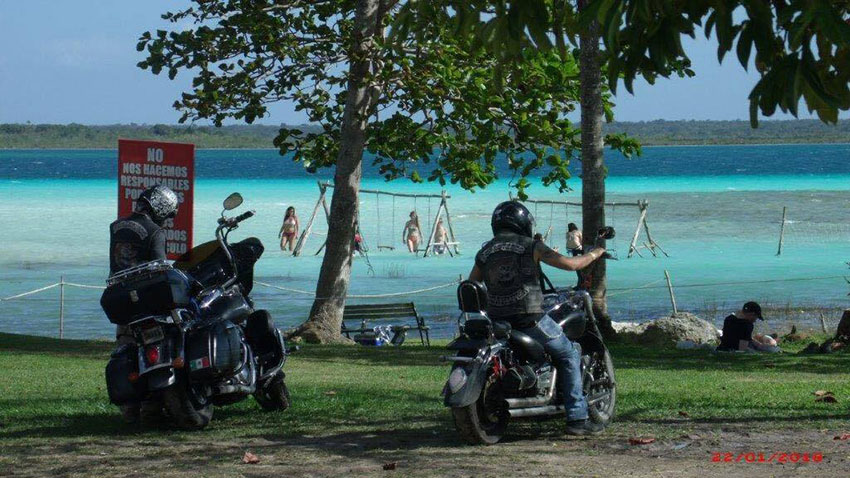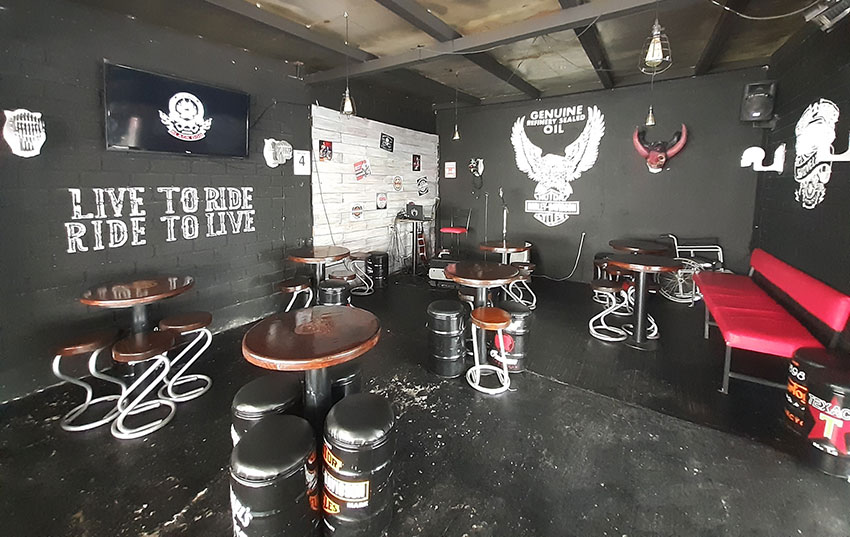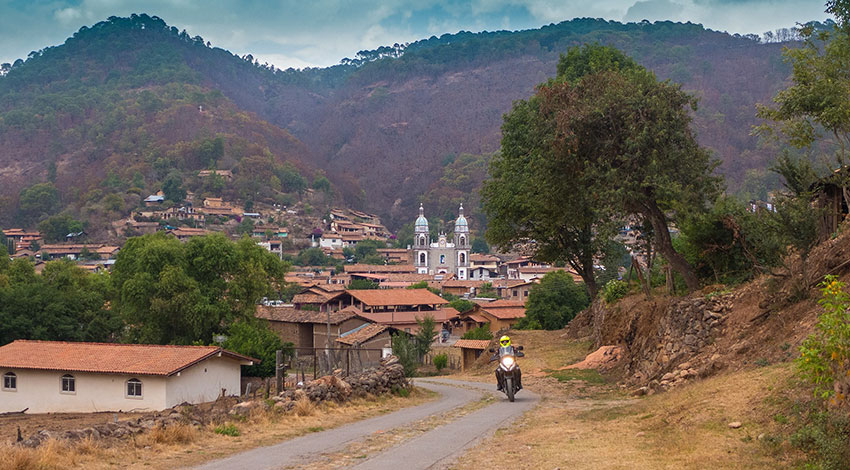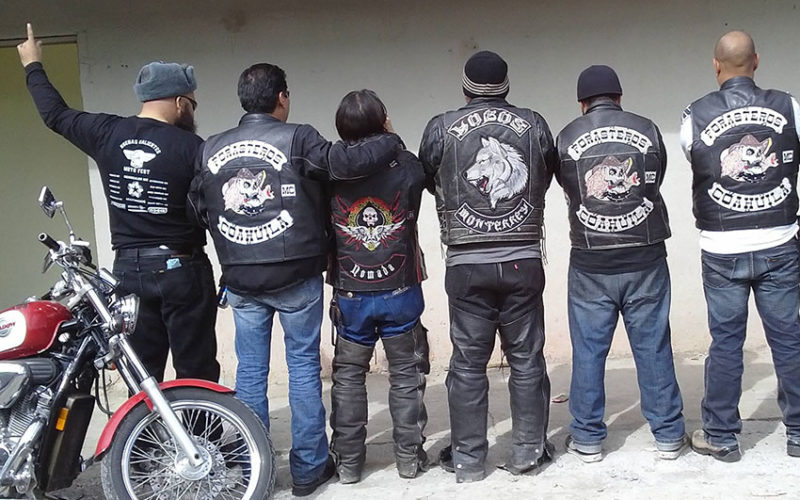As of 2017, there were over 3.5 million motorcycles on the roads of Mexico, a market that has been experiencing robust growth.
One reason is the availability of inexpensive, small bikes that are good for urban transportation, and indispensable with the rise of delivery services like Uber Eats.
Most motorcycling is practical urban transportation, but a “biker” culture of large cruisers on open highways does exist. Black leather jackets, boots, tattoos, certain bikes, and rock and roll dominate and on the surface, there is little to distinguish Mexican bikers from their U.S. counterparts. So are they simply mimicking? The answer is yes and no.
American media brought images of tough guys on Harleys to Mexico. It was adopted, and like in the U.S., the biker culture has since evolved. Mexico’s biker culture is more a homage to that north of the border, rather than a simple imitation, says Diego Piña, co-owner of the Black Dog House, a biker-themed bar in Querétaro.
The influence of the United States also extends to the negative stereotypes many non-bikers have, and unfortunately there are a few bikers who live up to the bad reputation. The lingering social stigma can mean that some bikers will hide their passion at their 9-5 jobs but pull out the stops on weekends. Mechanic Rene Esteves of Querétaro calls them “bikers de closet.”

Mexico does not have the same history of social rebellion like the United States, so what is the attraction? The principal answer is motorcycles themselves. Bikers find their passion young, attracted to the power and freedom from the mundane that the machines promise. In addition, there is an exoticism to the dress and social ritual.
Black Dog, with its chicken wings, onion rings, and live rock and roll, was like being back in college for me, but the Mexicans at my table found it both strange and wonderfully human at the same time.
That said, the biker culture has been around long enough to take on a “Mexican touch.” First is the image of singer and actor Pedro Infante. Starring in the movie A Toda Máquina (Full Speed Ahead, 1951), he gave Mexican riders an icon to go along with Elvis Presley and Marlon Brando.
Longtime biker Edgar Cisneros of Saltillo says that cruising bikes and rallies are more popular in the center and north of the country than in the south. The north has long distances to cross, requiring better planning, but it also has the drier weather and majestic scenery that most bikers crave. Many U.S. bikers come to Mexican events in the northern border states and Baja, and many norteños can get to U.S. events.
Rock and roll dominates by far among motorcyclists, but this is not absolute. Those riding urban sport bikes tend to prefer more modern dance music, and some cruisers favor mariachi and other older styles of Mexican music.
Perhaps the most “Mexican” adaptation is the involvement of religion. Pilgrimage to shrines has been mixed with the concept of group riding. Such rides occur all over Mexico, but the two most popular are to Our Lady of San Juan de Los Lagos, and Our Lady of the Favor in Hostitipiquillo, both in Jalisco. Many biker events will start by having a priest bless the helmets to protect the riders.

Family involvement is cited as extremely important by most Mexican bikers. Bikers Sally Mayer and Javier Ramos explain that a common way to include family members is to have them travel in cars behind the motorcycles so that everyone can get to the destination. Other ways include teaching children to ride and even having sidecars. One advantage of family events, Mayer says, is that there is far less drinking and drugs.
Serious motorcycling is not a cheap hobby. Long rides require good bikes, and the usual costs of travel. Some bikers do sacrifice other wants and needs for their obsession, but most are white-collar workers and business owners. Elitism, especially among Harley owners, is not uncommon, in part reflecting the country’s social stratification. One curious result is the banqueteros (sidewalk motorcyclists), who ride their expensive bikes on weekends to a local spot to show it off parked out front.
Many bikers have certain hangouts that they favor, but “biker bars” per se are rare in Mexico. The Black Dog House was established specifically to provide that kind of environment with some important modifications. The main one is that everyone, including non-bikers, are welcome as “there are no colors here.”
While “lone wolves” can certainly be seen in Mexico, organized group rides are the norm. One important advantage is safety; companions can help in case of an accident or other emergency, and groups of riders can fend off bullying cars and trucks on the highway. Many motorcycle organizations have developed almost military-like precision, with assigned roles and protocols.
The preference for organized rides means that biker events are popular and growing. The largest are in the Mexico City area along with the western and northwestern states of Jalisco, Zacatecas, Sinaloa, Sonora, Nuevo León, Chihuahua, and all of Baja California. They bring riders from all over Mexico, many from the United States, and even some from South America and Europe.
The largest is the Semana Moto Mazatlán, and another, Chikas Biker, is dedicated to women riders. Most events look to project a more positive image for bikers, often raising money and collecting donations for charity and having strict rules for behavior. Another important event is the Expo-Moto at the World Trade Center in Mexico City, which showcases 600 brands of motorcycles and accessories.

There are too many motorcycle groups to count in Mexico, which vary by membership requirements including type of bike, riding style, geographical location and sometimes sex, religion, socioeconomic status and more. There are also umbrella groups such as the Federación de Motociclistas and the Confederación de Motociclistas.
Interestingly, while there are expat motorcyclists they do not dominate the scene. Perhaps because of this, there are motorcycle tour businesses such as Bike Mexico in Puerto Vallarta, tours down the Baja peninsula highway from San Diego, and a Facebook group called Motorcycle Mexico.
Biker events can be an economic boon to cities and towns, as bikers spend money on gasoline, lodging, food, etc. Riders often go into rural areas that see little benefit from Mexico’s tourism industry. That is not to say that there are never any problems. Mayer likens biker events to rock concerts – most are fine, but there are some which cause problems.
Mayer and Ramos agree that motorcyclists wanting to join others in Mexico need to do their homework to find out which group is right for them, but “99% of motorcyclists are decent people.”
Make sure you have subscribed to our Facebook page or Twitter to stay tuned!
Source: Mexico News Daily by Leigh Thelmadatter
